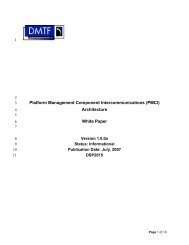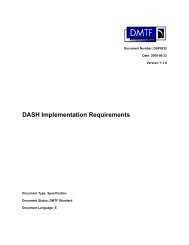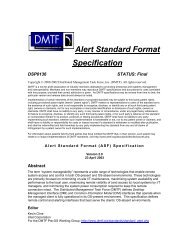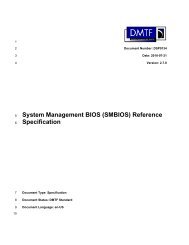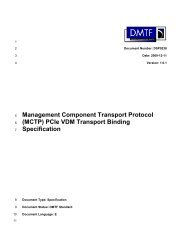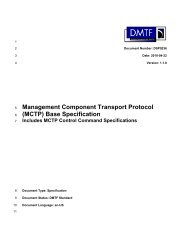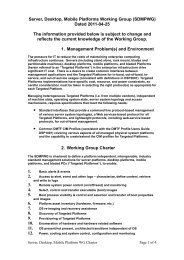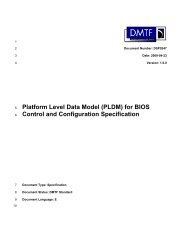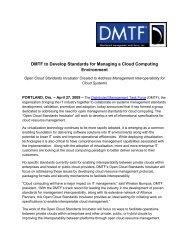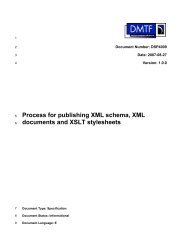Server Management Command Line Protocol Specification - DMTF
Server Management Command Line Protocol Specification - DMTF
Server Management Command Line Protocol Specification - DMTF
Create successful ePaper yourself
Turn your PDF publications into a flip-book with our unique Google optimized e-Paper software.
<strong>Server</strong> <strong>Management</strong> <strong>Command</strong> <strong>Line</strong> <strong>Protocol</strong> (SM CLP) <strong>Specification</strong><br />
745<br />
746<br />
747<br />
748<br />
749<br />
750<br />
751<br />
752<br />
753<br />
754<br />
755<br />
756<br />
757<br />
758<br />
759<br />
760<br />
761<br />
762<br />
763<br />
764<br />
765<br />
766<br />
767<br />
768<br />
769<br />
770<br />
771<br />
772<br />
773<br />
774<br />
775<br />
776<br />
777<br />
778<br />
779<br />
780<br />
781<br />
782<br />
783<br />
784<br />
785<br />
786<br />
787<br />
788<br />
789<br />
790<br />
791<br />
792<br />
793<br />
794<br />
5.1.6.1 General<br />
Implementations of the CLP shall return a <strong>Command</strong> Status of COMMAND PROCESSING FAILED and a<br />
Processing Error of COMMAND SYNTAX ERROR if a completely formed command is not contained in a<br />
single text message transmission of the underlying transport protocol. Implementations shall validate<br />
every <strong>Command</strong> <strong>Line</strong> against the clp-command-line production of the grammar specified in<br />
154HAnnex A. When a <strong>Command</strong> <strong>Line</strong> does not comply with the clp-command-line production of the<br />
grammar defined in 155HAnnex A, the implementation shall return a <strong>Command</strong> Status of COMMAND<br />
PROCESSING ERROR and a Processing Error of COMMAND SYNTAX ERROR. There are error<br />
conditions identified by this specification that can be detected by validation against the grammar for which<br />
this specification identifies specific values for Processing Error that are required to be returned instead.<br />
When specified, the requirement to return specific values supersedes the requirement to return the<br />
general COMMAND SYNTAX ERROR.<br />
EXAMPLE The create command requires a command target term to be specified. The specific Processing<br />
Error of MISSING REQUIRED TARGET is required to be returned if the command target term is not included.<br />
The grammar also requires that a command target term be specified in the create-cmd production. Thus, if a<br />
command target term is not specified, the <strong>Command</strong> <strong>Line</strong> will fail validation against the grammar and a<br />
COMMAND SYNTAX ERROR would be appropriate. However, this general Processing Error is superseded by<br />
the specific Processing Error specified for the error condition.<br />
5.1.6.2 Job Visibility<br />
A command is processed by the <strong>Command</strong> Processor component of the SM architecture. The <strong>Command</strong><br />
Processor returns a response and control to the Client for each command received. <strong>Command</strong>s and the<br />
subordinate activities generated when processing commands are tracked by the implementation. A job is<br />
defined as an identifiable activity of a MAP. The implementation spawns and manages jobs for a<br />
command and any subsequent actions that are taken to carry out the command request. When an<br />
implementation receives a command, the command becomes a job. The command job may generate<br />
additional subordinate Managed Element jobs in order to complete the task requested by the command<br />
verb, but the implementation shall not expose these jobs through the CLP. The command job shall<br />
continue to exist until any and all jobs spawned by the command have completed, a <strong>Command</strong> Response<br />
has been returned to the Client, and the Time Before Removal has not expired.<br />
By default, the implementation shall return a <strong>Command</strong> Response and session control to the Client within<br />
a reasonable period of time, regardless of the status of command execution. Returning a response and<br />
control prevents the CLP session from blocking indefinitely if a command takes an unreasonable amount<br />
of time. The definition of "a reasonable period of time" is implementation specific. Any mechanisms for<br />
modifying this value are outside the scope of this specification and are implementation specific.<br />
When the implementation returns a <strong>Command</strong> Response synchronous with completion of the command<br />
job, the <strong>Command</strong> Response shall contain the <strong>Command</strong> Status and the complete <strong>Command</strong> Results.<br />
When the implementation returns a <strong>Command</strong> Response before the command job completes, the<br />
<strong>Command</strong> Response shall contain the <strong>Command</strong> Status of COMMAND SPAWNED and the Job Identifier<br />
for the continuing command job.<br />
The implementation shall manage the command job until it completes and persist the <strong>Command</strong> Status<br />
when complete, identified by the Job Identifier. The implementation is not required to maintain the<br />
<strong>Command</strong> Results for the command. Implementations shall recognize the Job Identifier as an identifier<br />
used to obtain status information about the continuing command and to retrieve the <strong>Command</strong> Status<br />
when the command job is complete. The Job Identifier shall be the Instance Suffix for the UFiT of the<br />
instance of CIM_ConcreteJob used to represent the job in the job queue. After the <strong>Command</strong> Status<br />
holding time has expired, the corresponding job is deleted and the Job Identifier is released.<br />
Implementations shall also implement a user-controlled holding time for <strong>Command</strong> Status, controlled by a<br />
per-command option. Use of this option is documented in Error! Reference source not found.. Every<br />
command job has a Time Before Removal associated with it. The Time Before Removal indicates the<br />
amount of time that a command job is managed by the MAP after completion. The command job itself is<br />
22 Version 1.0.2



